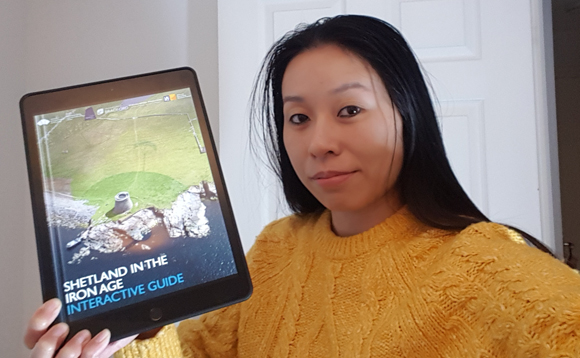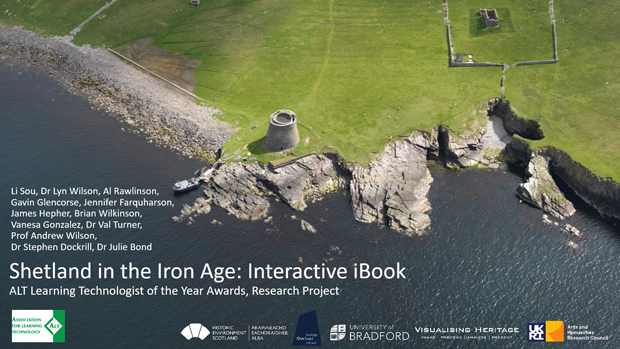Interactive “I-Book” Provides Readers with Unprecedented Access to Archaeological Sites
An interactive ‘”I-Book” which allows users to virtually walk around otherwise inaccessible historical sites has been shortlisted as a finalist in a major award. Entitled “The Shetland in the Iron Age”, this Interactive “I-Book” gives anyone a VIP pass to three distant archaeological sites and has been highly commended in an industry awards ceremony.
Interactive “I-Book”
The concept of providing virtual access to sites of great historical significance was developed by Archaeological and Forensic Sciences PhD student Li Sou from the University of Bradford. The “I-Book” offers a no-holds barred tour of three “broch”, Iron Age drystone hollow-walled structures found in the Shetland Islands, Scotland. The technology is so simple to use, that anyone aged nine or over can use the “I-Book” and visit relatively remote and inaccessible sites.
University of Bradford Student Li Sou Demonstrates the “I-Book”

Picture credit: University of Bradford
The “I-Book” provides 360° virtual maps of the interiors that users can explore. Virtual visitors can wander around their inner workings, exploring different buildings, accessing staircases and corridors, as though they were there in the Shetlands themselves.
Providing Lots of Associated Information and Data
The cleverly designed “I-Book” includes clickable information hotspots that link to a wealth of associated data, including historic photographs and videos from experts in the field. The concept was shortlisted in the Association for Learning Technologists Awards and the “I-Book” was highly commended. The judges describing it as an “incredibly varied, engaging and accessible digital educational resource.”
Historic Environment Scotland have been developing this technology for use at other historic properties in their care and these will launch in 2021, both on site and freely downloadable online.
An Overhead Photograph of a Broch
Picture credit: University of Bradford
The judging panel stated that the project:
“Has excelled in developing a range of versatile digital assets to aid in learning about complicated archaeological and academic themes.”
Commenting after the prestigious award ceremony, student Li Sou exclaimed:
“This is the culmination of a six-month project and brochs are complicated archaeological sites to understand and are not physically accessible to everyone. The I-Book format is not very well known in the heritage sector, so the project was an excellent opportunity to design a resource that gives readers a chance to explore the sites as if they were there in real life, with integrated accessibility features to make them accessible to all.”
A Useful Resource in the Midst of a Global Pandemic
The use of technology such as this has significant implications for the support of archaeology and general education in the midst of a global pandemic. The emergence and spread of COVID-19 has curtailed travel and restricted the opening times for heritage monuments. “I-Books” such as this permit sites that might be closed to the public and otherwise difficult to reach due to the need to restrict travel or to self-isolate, to still be accessible to students, archaeologists and the general public.
“I-Book” Development Team Photo (in an Age of Social Distancing)
Picture dredit: University of Bradford
The interactive “I-Book” entitled “The Shetland in the Iron Age” was developed in collaboration with the Shetland Amenity Trust with a working group from Historic Environment Scotland, along with the co-operation and assistance of the Visualising Heritage group within the School of Archaeological and Forensic Sciences, University of Bradford.
Implicatioms for Palaeontology Departments
A spokesperson from Everything Dinosaur commented that this type of technology has applications within the Earth sciences. For example, interactive “I-Books” could be provided to help students and researchers virtually visit remote dig sites and fossil quarries. It could also be used in other research areas such as allowing observations of fossil collections and other material that would otherwise be very difficult to access.
Everything Dinosaur acknowledges the assistance of a media release from the University of Bradford in the compilation of this article.
Visit the Everything Dinosaur website: Everything Dinosaur.








Leave A Comment